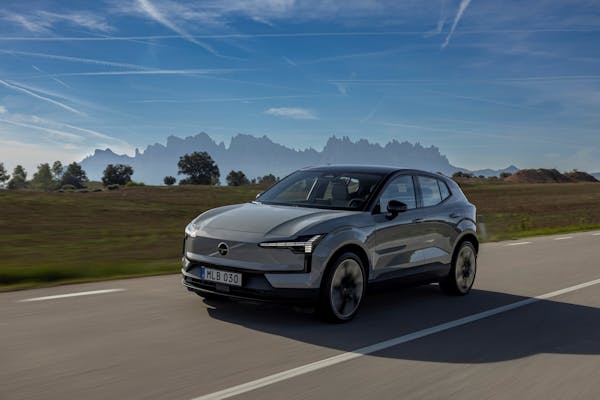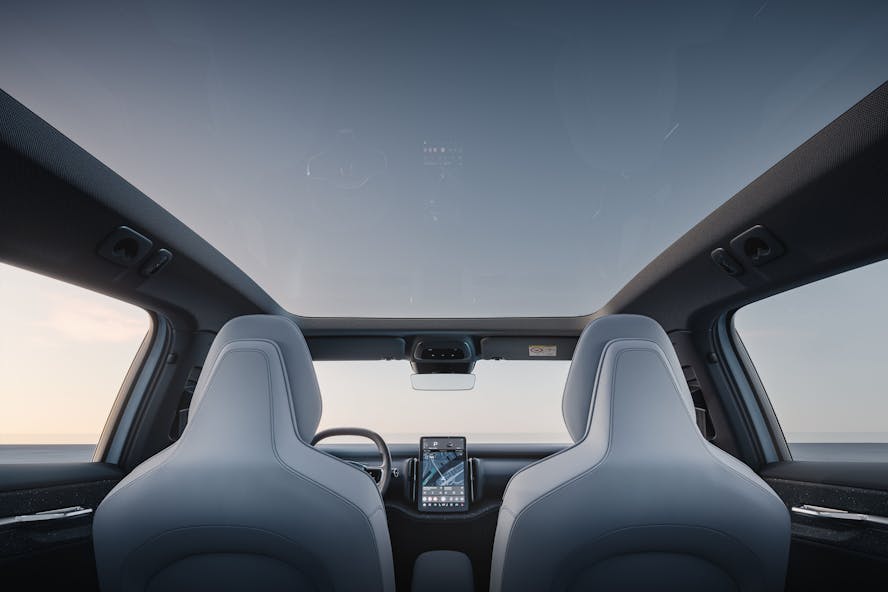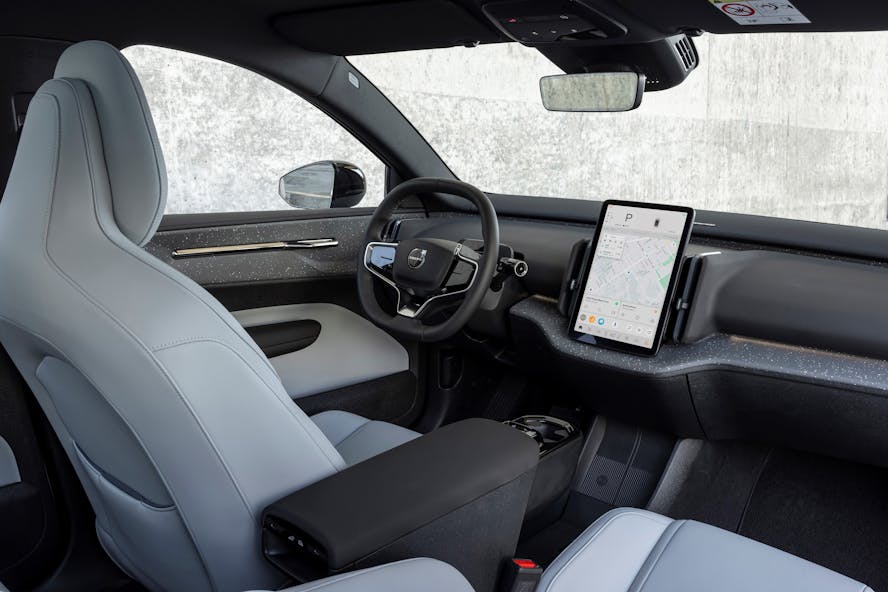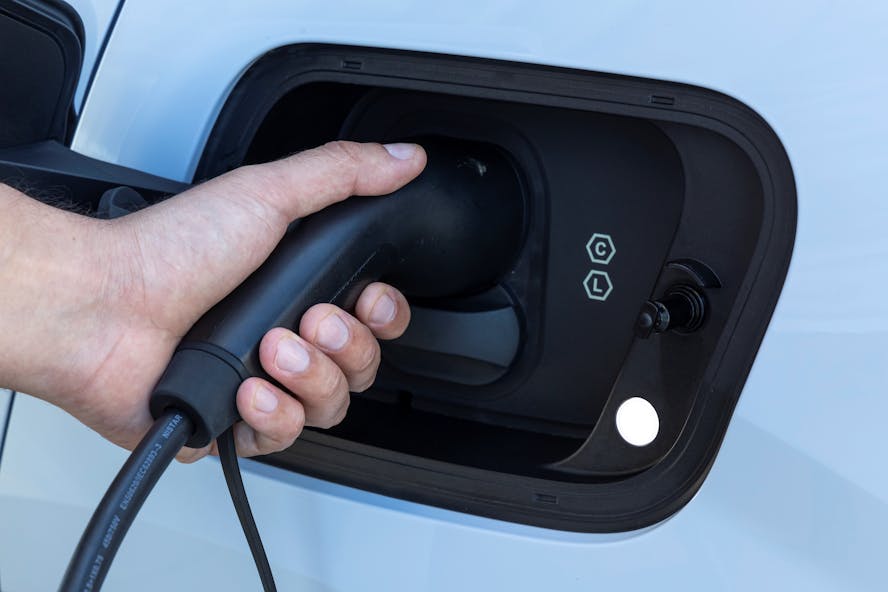Volvo EX30 Review
The Volvo EX30 is a compact SUV, available in rear-wheel drive or all-wheel drive form, and it offers the most agile driving experience of any electric Volvo.
This is a review for the Volvo EX30
-
Agile driving experience (despite weighing 1,885 kg in AWD form)
-
Rear-wheel drive or all-wheel drive
-
Twin Motor model delivers rapid 0-62 mph acceleration time of 3.6 seconds
-
All car controls and information on one central display
Design & Powertrain

The Volvo EX30 is a compact SUV, a category of car that’s in big demand with consumers, and it looks very modern and stylish both on the outside and in the interior, which features one of the most minimalistic dashboards that you’ll come across.
There are three versions of the Volvo EX30: Single Motor RWD, Single Motor Extended Range and Twin Motor Performance. The Single Motor RWD model has a 51 kWh battery (49 kWh usable capacity) and rear-wheel drive. The Single Motor Extended Range model is rear-wheel drive and the Twin Motor Performance is all-wheel drive, and both have a 69 kWh battery (64 kWh usable capacity).
All models have a 272 hp rear electric motor, with the Twin Motor Performance version adding a 156 hp front electric motor, giving a total system power of 428 hp and 543 Nm of torque, compared to 343 Nm for the single motor variants.
The EX30 has a 318-litre boot, with luggage space increasing to 904 litres if the rear seats are folded down, and there’s a very small ‘frunk’ under the bonnet. Legroom for rear seat occupants is on the tight side, but fairly typical for this size of car.
Between the two front seats is an armrest; underneath this is a storage compartment that you can pull out, and if you want to use this for drinks, there’s another element that you can pull out to lock drinks in place. Under this, on the floor, is a large storage compartment, with the option to adjust it to make it deeper. All these features are thoughtful, neat design touches.
The EX30 has a maximum towing weight of 1,600 kg.
Driving Experience
The Volvo EX30, both in rear-wheel drive and all-wheel drive form, is the most agile electric Volvo to drive - despite the Twin Motor model weighing 1,885 kg. The rear-wheel drive variant has a slight edge in the driving agility department due to its slightly lower weight and the fact that the front wheels are only doing the steering, not the driving. As well as responsive steering and enjoyable handling, ride quality is also excellent – although the short wheelbase can result in it being a bit bouncy on some road surfaces. Overall the EX30 delivers big car levels of refinement in a small package.
The EX30 has a total of zero displays in front of the driver – there’s just a 12.3-inch centre console touchscreen - and virtually no physical buttons on the dashboard (there’s a small area of plastic above the steering wheel but this isn’t for the driver, it’s for the car to monitor the driver. So, like the Tesla Model 3, there’s no speed read-out in front of the driver, and no head-up display. Volvo says that because the EX30 is a small car you can easily see the speed on the central screen, but surely cost considerations are a factor in only having one display.
The tall central screen displays sharp Google satellite mapping, but because all car controls are on this screen, it’s no surprise that there are lots of menus and sub-menus (including the ability to change all-wheel drive to rear-wheel drive, although there’s no option to choose different driving modes). However helpfully there’s one screen for ‘quick controls’, which provides options to select ‘one pedal drive’ (the gear selector on the right stalk on the steering column doesn’t give you any regenerative braking options), as well as the ability to switch off the lane keeping aid and the speed limit warning.


Despite the EX30 having voice-activated control, in our view having all car controls on the central screen doesn’t make the car as safe to drive as having important car controls that are easy to see and reach without having to delve into a touchscreen. Even the switch for the hazard warning lights is on the screen. We wonder what happens if the screen stops working – something we’ve experienced in other cars, as have fellow motoring journalists.
In the quest to remove buttons, there are even no buttons on the inside of the doors. The window switches have moved to the middle of the car, and there are just two; borrowing Volkswagen’s idea from the ID.3 and ID.4, there’s a separate button to make the switches work for the rear windows. Volvo says that the removal of switches from the doors is in the pursuit of sustainability, as there are less wires and other materials.
Even the electric driver’s seat only has one control, which has become multi-functional, moving the seat forwards, backwards, up and down, as well as adjusting the angle of the seat base and back rest.
In another display of minimalism, the EX30’s key has no buttons on it – you walk towards the car and it unlocks, and you walk away from the car and it locks.
Range & Charging
The Volvo EX30 Single Motor RWD has an electric driving range of up to WLTP 209 miles from its 51 kWh battery. The EX30 Single Motor Extended Range model delivers a range of up to 295 miles from its 69 kWh unit, and, with the same battery, the Twin Motor Performance variant can manage up to WLTP 279 miles.

The larger battery can be ultra-rapid DC charged at up to 153kW (as opposed to a more typical ‘round figure’ such as 150kW), which should result in a 10% to 80% charge in 28 minutes.
Using 11kW three-phase power, typically found at a workplace in the UK, a 0% to 100% charge should take 11.5 hours.
Price and Model Range

The Volvo EX30 Single Motor RWD Plus model is available from £33,795, the Single Motor Extended Range from £38,545, and the Twin Motor Performance AWD Ultra from £44,495. Plus or Ultra trim levels are available. The Single Motor Extended Range model in Plus trim is expected to be the biggest seller. There are also four interiors for the EX30: Breeze, Mist, Pine and Indigo.
In addition to the Plus features, the Ultra model has additional equipment including 360 degree camera with virtual 3D view, Park Pilot Assist, 20-inch alloy wheels, dark tinted rear side windows and rear screen, fixed panoramic sunroof, power driver seat and passenger seat, memory for door mirrors and power driver seat, 3-phase, 22kW on-board charger, soundbar, and five ambience themes.
Conclusion
The EX30 is the most agile electric Volvo to drive, despite its kerb weight of 1,885 kg in AWD form, and its 0-62 mph acceleration of 3.6 seconds would have been in supercar territory only a few years ago. It looks stylish on the outside, and it’s a similar story in the interior. However its minimalistic dashboard also means that all car controls and driving information is on the central touchscreen – there’s no instrument display or head-up display in front of you. This has been done before, in cars such as the Tesla Model 3, and some drivers might be fine with this, but some other car manufacturers are now going back to physical buttons for key car controls, so Volvo’s approach is not for everyone. So if you can live with nothing on the dashboard apart from a screen, then the EX30 offers agility, performance, and big car refinement in a compact SUV package.
Equipment Highlights
-
Front and rear parking sensors
-
Rear parking camera
-
Power-operated tailgate
-
Heated front seats
-
Heated steering wheel
-
Automatic LED headlights with active high beam
-
Harman Kardon dashboard soundbar system
Choose your EX30 car lease
Volvo EX30 200kW Single Motor Core 51kWh 5dr Auto
- £3,555.32 Initial rental (ex. VAT)
- £4,266.39 Initial rental (inc. VAT)
- 48 Month term
- 5000 Annual mileage
- Subject to status and conditions + arrangement fee
Volvo EX30 200kW Single Motor Plus 51kWh 5dr Auto
- £3,774.94 Initial rental (ex. VAT)
- £4,529.93 Initial rental (inc. VAT)
- 48 Month term
- 5000 Annual mileage
- Subject to status and conditions + arrangement fee
Volvo EX30 200kW SM Extended Range Core 69kWh 5dr Auto
- £3,829.82 Initial rental (ex. VAT)
- £4,595.79 Initial rental (inc. VAT)
- 48 Month term
- 5000 Annual mileage
- Subject to status and conditions + arrangement fee
Volvo EX30 200kW SM Extended Range Plus 69kWh 5dr Auto
- £3,890.09 Initial rental (ex. VAT)
- £4,668.11 Initial rental (inc. VAT)
- 48 Month term
- 5000 Annual mileage
- Subject to status and conditions + arrangement fee
Volvo EX30 315kW Twin Motor Performance Plus 69kWh 5dr Auto
- £4,237.31 Initial rental (ex. VAT)
- £5,084.77 Initial rental (inc. VAT)
- 48 Month term
- 5000 Annual mileage
- Subject to status and conditions + arrangement fee
Volvo EX30 200kW SM Extended Range Ultra 69kWh 5dr Auto
- £4,349.17 Initial rental (ex. VAT)
- £5,219.00 Initial rental (inc. VAT)
- 48 Month term
- 5000 Annual mileage
- Subject to status and conditions + arrangement fee
Volvo EX30 315kW Twin Motor Performance Ultra 69kWh 5dr Auto
- £4,485.78 Initial rental (ex. VAT)
- £5,382.93 Initial rental (inc. VAT)
- 48 Month term
- 5000 Annual mileage
- Subject to status and conditions + arrangement fee
Volvo EX30 315kW TM Perf Cross Country Ultra 69kWh 5dr Auto
- £4,948.55 Initial rental (ex. VAT)
- £5,938.26 Initial rental (inc. VAT)
- 48 Month term
- 5000 Annual mileage
- Subject to status and conditions + arrangement fee